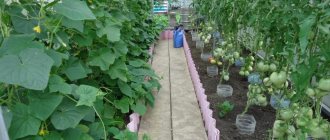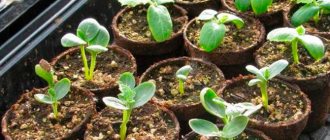The stereotype has long been ingrained that in order to enjoy juicy ripe watermelons and melons, you need to go to the Krasnodar Territory or somewhere else to the south. But that's not true. Even residents of the Urals and Siberia can easily grow their own melons, providing them with all the necessary conditions.
By the way, here are some excellent varieties of watermelon for Siberia: Ogonyok, Crimson Sweet, Siberian Lights. And here are the melons: Altai, Luna, Rosinka, Tender, Galileo, Kolkhoznitsa 749. Take note.
Is it possible to plant melons and watermelons together and at what distance?
Melons grow well next to each other, so they can be planted side by side. They need the same growth conditions:
- Since they originate from hot countries, they love the sun and warmth;
- They require approximately the same care;
- Cross-pollination usually does not occur.
But it is important to remember a few nuances:
- It is necessary to carefully calculate the planting site, since melons usually grow greatly. The distance between plantings should be at least 70 cm.
- In addition, they are susceptible to various diseases, so regular preventive measures should be taken as a rule.
Rules of care
In the process of growing melons, certain care is required.
To obtain smooth and juicy fruits, you will need to pinch the growing point above the fifth leaf. A week later, two shoots are cut off from the very bottom. Melons are pinched after the stem has formed. A necessary condition for caring for watermelons: there should be 5-6 ovaries on one stem. Pruning is carried out without overall damage to the sprout. In some places, the lashes are covered with earth to form additional roots. The lashes are tied to the trellises on both sides of the main shoot, removing the shoots.
During ripening, this kind of care is necessary: create a lot of light and warmth. If the temperature in the greenhouse is more than 300C, it is ventilated. If the vines are slightly wilted, this indicates a lack of water in the soil. When growing watermelon in a light polycarbonate greenhouse, it is important not to skip the pollination period. If these are non-fertile male flowers, they will disappear during the growth process; female flowers are pollinated in three days.
Tip: In order for bees to easily penetrate the greenhouse, the film must be open. To attract bees, plant leaves are sprayed with sweet water.
If artificial pollination is required, it is carried out by picking large male flowers and applying them to female flowers. For pollination, repeat the action several times. During fruit ripening, watering should be stopped - this will help not spoil the taste and appearance of watermelons.
Installing a furniture eccentric - 100 photos and step-by-step video instructions on how to properly install a furniture eccentric
Soil selection
The area for planting melons and watermelons should be reliably protected from the wind and well lit by the sun. The key to success is the right soil, providing the plants with a sufficient amount of necessary substances.
- The ideal option is sandy, sandy loam soil or light loam.
- The hydrogen content is important; it should reach 6-7 units.
- The soil for melons should be light, neutral, an abundance of various organic compounds is important.
- Excessive moisture and acidic soil are absolutely not suitable for growing melons and watermelons.
Do we need “neighbors”?
To prevent the greenhouse from standing idle waiting for the right temperature to create melons, you can sow early greens or radishes in it. Precursors will not harm watermelons and melons. Melons will develop well next to drought-resistant , light-loving tomatoes and eggplants.
Moisture-loving cucumbers and bell peppers will not be the best neighbors. Adherents of hot, dry climates, watermelons and melons suffer from diseases (powdery mildew, angular spot, downy mildew) at a humidity of sixty percent.
Planting watermelons and melons with seeds in a greenhouse or open ground
The earliest time for sowing melons is April, but in cold regions it may shift slightly towards summer. Residents of the southern regions should make sure that the nights are warm enough and the soil is well warmed up before planting.
If residents of cooler regions take up growing melons, it is better to stick to the seedling method.
Preparing seeds for sowing
Before planting, you can treat the seeds; as a result, not only does germination increase, but the seedlings also develop faster and are stronger and healthier. It also ensures the future ovary of female flowers, from which fruits are subsequently produced.
Treatment:
- First, you need to manually sort through the seeds and throw away any that are known to be defective. Then the seed material must be placed in a small cotton bag, which is soaked in hot water for three and a half hours.
- After this, the bag is transferred to a cool, weak solution of potassium permanganate for half an hour. This procedure will disinfect the seeds.
- The next step is to carefully remove the processed seeds with tweezers and place them on paper napkins, which are previously laid on the bottom of a plastic container. The napkins must be pre-moistened with settled water.
- The result was a kind of small greenhouse. It is left for a day and a half in a warm place, you can use the battery. After the specified period, the main spine will appear. After this, you can plant the seed either in open soil or in a greenhouse.
- You don’t have to process purchased seeds, since the manufacturer has already done all the necessary manipulations.
Sowing watermelons and melons with seeds in a greenhouse or open ground
First you should prepare the place where the melon plant will be located. An area on the south side of the site, well protected from the wind, is best suited. The site must be dry, without close groundwater.
You can artificially drain it by making beds up to 20 cm high and forming a slope towards the south.
There are two common sowing options - in furrows or holes. There should be a considerable gap between the seedlings - at least 70 cm, so that the seedlings do not interfere with each other and have enough space to grow.
- Planting in furrows . They should be located about a meter and a half from each other. A distance of 3-4 cm is maintained between the seeds. This option is usually used in regions with cold climates, where not all seeds germinate. If germination is good, the planting can then be thinned out or replanted.
- Planting in holes . In this case, it is necessary to maintain a distance of at least half a meter, or better yet, a meter. No less than 2 and no more than 5 seeds are planted in each hole. After sprouting, it is necessary to remove excess sprouts.
How to avoid mistakes?
In some cases, melon berries do not set. This happens due to mistakes made.
- Wrong choice of seeds. It is better to buy them in specialized stores. Pay attention to the expiration date and permissibility of cultivation in a particular region;
- Violation of the conditions for growing seedlings and fruit-bearing plants. The formation of lashes, garter, pollination influence the formation of ovaries;
- Low ambient temperature. In cold, rainy summers, it is necessary to provide additional heating to the greenhouse and illuminate the plants with LED or sodium lamps.
Subject to simple planting and care conditions, melons and melons in protected soil will grow no worse than under the southern sun. Ecologically clean, nitrate-free watermelons and melons will delight gardeners with a bountiful harvest and excellent taste.
Useful video:
Caring for melons and watermelons after planting
A good harvest is possible only if the plants are cared for promptly and carefully. Do not neglect loosening the soil, weeding, and watering. It is important to apply fertilizers on time and take measures against diseases.
Watering
Watermelons and melons are moisture-loving plants. Their juiciness depends on timely and sufficient watering. There should be at least 30 liters of water per square meter, which must first be left standing for 24 hours.
Watering should be done once every seven days. If dry weather occurs, watering is done twice a week.
Additionally, it is necessary to irrigate the melons superficially, adding fertilizers. It is recommended to alternate feeding, using both fertilizers for the root system and shoots.
The more the fruits gain weight, the more watering is reduced. Finally, it should be stopped a week before harvest. This trick has a noticeable effect - sugar accumulates in the pulp during this time, as a result the fruit becomes very sweet and aromatic.
After watering, the soil must be loosened to prevent rapid evaporation of moisture.
Top dressing
This manipulation is carried out 14-15 days after sowing the seeds.
The first fertilizing is done with ammonium nitrate. There should be 20 grams per bucket of water. of this substance. The resulting solution in an amount of two liters is added to each well.
The second feeding is necessary when the formation of buds begins. During this period, 4 grams are needed for each plant. calcium chloride, the same amount of ammonium nitrate and 6 g. superphosphate.
How to properly care?
The work of obtaining a decent harvest is not labor-intensive , but it requires compliance with certain conditions.
- A properly formed plant will produce good fruiting.
- Watermelons and melons need to be given a lot of sun and warmth.
- Humidity should be low.
- A garter to the trellises is required.
- The yellow flowers that appear indicate the need to move on to the next stage - pollination.
- Melons growing in a greenhouse require mandatory feeding with wood ash.
- Melon crops should not touch the ground.
How to grow melons in a polycarbonate greenhouse? When growing a melon, pinch the growing point above the fifth leaf (as on cucumbers). In a week and a half to two weeks, the shoots of the lower row will appear. The weak ones must be removed immediately. On all strong shoots, stop the growing point. Important! If you want to get sweet, juicy large fruits, one berry should grow on each vine.
To do this, wait until the ovaries grow to five centimeters. Choose the largest one with the correct shape. The remaining ovaries and flowers will have to be removed , even if you like them. Otherwise, you'll end up with a lot of small, unsweetened, grassy-tasting fruits.
In watermelons, pinch off the growing point above the fifth leaf. Later, the two lower shoots are removed (the flowers on them grow late, the fruits do not have time to ripen). Subsequent lashes are tied to trellises on both sides of the main shoot. Shoots without ovaries are removed.
Lateral shoots with ovaries are stopped above the third leaf above the female flowers, above the seventh above the male flowers. For watermelons, it is optimal to leave more than five to six fruits on one plant .
A temperature of 30ºC is considered favorable for the development of melon crops. During prolonged heat, the greenhouse is ventilated by opening the windows or doors. This measure prevents the formation of condensation. Important! Melon can easily withstand any heat. Watermelons should be covered with protective material from the scorching heat. You can plant a trailing plant (such as a climbing bean).
Watermelons and melons have deep root systems that allow them to extract water underground. If overmoistened, the roots will rot and cracks will appear on the fruits. The plants themselves will report a lack of moisture. If the leaves have wilted, it is time to water. The drip irrigation system has proven itself well, preventing water from getting on the leaves.
This should be done when the plants are still short, under the second or third leaf. As they grow, the lashes are tightened.
It is important not to waste time. The male flowers will fall off within a few hours. Females are capable of pollination within three days. Melons can pollinate on their own. But for this we need living helpers - bees.
In their absence, you will have to take the pollination process into your own hands. Find male flowers. They are large and without an ovary. Pluck them and remove the petals.
Do this very carefully. Don't shake off the pollen. Apply the stamens of male flowers to the pistils of female flowers several times.
It gives the berries a sweet taste. Ash is especially important for melon. Mineral fertilizers are applied once a month. Every ten days, it is recommended to water the plants with ammonium nitrate diluted in water (15 grams per 10 liters of water). Important! As soon as the fruits begin to ripen, stop feeding.
There are several ways to solve the problem:
- Place each ripening fruit in a separate net and tie it to the trellis. This is the best method to preserve watermelons and melons.
- Place a board under the watermelon or melon. This method is good only for the lower fruits (or you will have to bend the lashes to the ground). The disadvantages include the need to regularly turn the berries to ensure uniform ripening.
- Make shelves from any material and attach them to the walls of the greenhouse. The fruits will also have to be turned over.
- Sometimes cardboard boxes are used instead of nets. They are difficult to attach to trellises, and it is difficult to monitor the development of the fruit.
The ripeness of watermelons will be indicated by shiny bark with a clear pattern , a shrunken stalk and a characteristic dull sound when hitting the berry. Ripe melons emit a unique aroma. The harvest is stored in cardboard boxes. It is advisable to place each fruit in a separate container.
Planting watermelons and melons as seedlings in open ground or a greenhouse
Now let’s consider the option of growing melons using seedlings.
Seed preparation
To get a good result, planting material must be prepared in advance. Seeds should be purchased in early spring, at least two months before planting. An important nuance - preference should be given to seeds obtained five years ago.
When deciding on a variety, you need to take into account the climate. The colder the region, the more early ripening the variety should be.
It is ideal to focus on hybrids that already have adaptation to various unfavorable factors.
Purchased seeds must be checked for germination. To do this, you need to immerse them in a container of water. Those that float up are immediately thrown away, as there is no sprout in them. The remaining seeds can be planted in the ground to produce seedlings. Watermelon seeds have a harder shell, so germination time is much longer. To reduce it, you can pour boiling water over them.
First of all, the seeds need to be soaked. First, they must be sorted by variety, then wrapped in gauze, folded in several layers. All this is immersed in a container with a little water at the bottom. The seeds are soaked until the first shoots appear. If a lot of time has passed and the sprouts cannot be seen, the seeds can be postponed until next year. They should be dried and stored in the refrigerator.
Seedling growth
The next stage is preparing the pots. There should be as many of them as there are seeds. Containers need no more than 10 cm in diameter. They are filled with high-quality peat soil. You can add useful organic matter, such as humus, sawdust, and turf. These additives help retain heat, which is extremely important for melons.
Two hatched seeds are planted in each container, deepening them 5 cm. After this, the surface should be irrigated with a spray bottle, covered with a transparent film and kept warm. The pots are kept at a temperature of about +25 degrees from one month (melons) to one and a half months (watermelons).
After the sprouts appear, the film should be removed and the pot should be moved to the sun. A week after planting, mineral fertilizers are applied. At the same time, you can start preparing a tincture of mullein and superphosphates; it will come in handy in another seven days.
Choosing a place to plant watermelon and melon seedlings in the ground
Growing melons requires a lot of patience and attention. Close attention should be paid to the area. If you cannot find a sufficiently warm, sunny, wind-protected place, then it is better to use a greenhouse to get a good harvest.
Preparing seedlings for transplanting into soil
As soon as 5-7 leaves have formed on the seedlings, you can begin preparing to move them into the ground. The optimal time is the end of May. But if during this period the air temperature at night drops below 15 degrees, you should wait a few more days.
A week before planting, the hardening of the sprout begins. The plant is kept at temperatures from +16 to +20 degrees. This will give you the opportunity to gradually get used to the new conditions.
Scheme of planting seedlings of watermelons and melons and open ground or greenhouse
The comfort of the plant will ensure a good harvest. To get it, you need to follow a few simple rules:
- Care should be taken when preparing the site. The holes are made at a distance of at least 50-70 cm. Approximately 70 cm should be left between the rows.
- The holes are staggered, which gives access to each plant and room for development.
- When planting, the top leaves are left outside, the soil around the sprout is compacted and sprinkled with a layer of sand. This is necessary to prevent rotting.
- After planting, the sprout is watered with warm, settled water.
For the first few days, each sprout is covered with a moistened plastic cap. Weak and tender seedlings are initially very sensitive to aggressive sunlight.
Caring for watermelons and melons after planting seedlings in the ground
After the seedlings are planted in the soil, they should be sprinkled with a little sand. For several days after transplantation, the plants take root; during this period they need to be slightly shaded and watered with heated water every day. Watering is gradually reduced.
Fertilizer application takes place in three stages.
- Seven days after landing. To do this, approximately 25 grams are dissolved in a bucket of water. ammonium nitrate, 50 gr. superphosphate, about 20 g. potassium nitrate.
- During the period of lash formation. Mullein should be added to the water, keeping a proportion of 1:10 or chicken manure (1:20), add 20 grams. superphosphate and 30 gr. potassium salt.
- The third feeding is done when the first fruitful ovaries appear. Add 15 grams to a bucket of water. ammonium nitrate, 30 gr. potassium nitrate and 10 gr. superphosphate.
Melons have no problems with pollination. This is facilitated by about 150 different species of insects, including ants. Many gardeners, not knowing this fact, strive to destroy ants, thereby reducing the possibility of pollination.
Proper preparation of the greenhouse is the key to success
Use tall structures. Heat-loving melons cannot grow outdoors; the soil should be protected. A greenhouse is not suitable for this - it is too small. In order to grow watermelons and melons, any type of greenhouse is suitable with the only condition: its height must be at least 1.7 m, and preferably about 2 m. As these plants grow, they climb high on the trellises, so they may not be of small height grab
Provide plants with a separate home. Watermelons and melons also grow well next to other plants: cucumbers, peppers, eggplants. However, experienced summer residents recommend using a separate greenhouse for growing melons. This will allow you to select optimal conditions for southern berries: low air humidity and a temperature of about 30˚C. Plants can tolerate drought, but absolutely cannot tolerate high humidity. When humidity is above 60%, plants are susceptible to fungal infections.
Scheme of a greenhouse for growing watermelons and melons.
The greenhouse must be prepared in advance. At the end of March, it is cleared of snow, if there is any, and the building is carefully inspected outside and inside. All damage must be corrected: melons are afraid of cold weather, and any gap allows cold air to pass through and can lead to the death of seedlings. After the greenhouse is covered, you need to take care of the soil fertility: add neutral, not too greasy soil. Work on preparing the greenhouse can begin immediately after the snow melts.
To begin with, a greenhouse can be used for growing frost-resistant early ripening crops. Before growing watermelons and melons, plant radishes, greens, and daikon. Melons can only be planted in well-warmed soil, when frosts no longer occur. The greenhouse will already be free by then. Material to protect seedlings from sudden cold weather must be placed in the greenhouse in advance. It can be spunbond, rags, special film, paper - anything that can protect fragile sprouts.
Formation of melons
After the first two or three fruits appear on the watermelon shoot, the central lash is pinched. The lateral ones are also subjected to this procedure over the fifth or sixth sheet. All other ovaries will draw resources onto themselves, interfering with development, so they should be removed.
Scheme of watermelon formation
Melon formation diagram
The central strand of the melon also needs to be pinched. This is usually done over 3-4 sheets. Side shoots should be carefully examined and the two strongest ones should be preserved. They also need to be pinched, doing this over 5-6 sheets.
After the ovary has formed, another pinching is carried out over 3-4 leaves above the ovary. Weak shoots are removed. The optimal number of fruits on one shoot is no more than 5-6 pieces.
You can organize the formation on a trellis. The lash needs constant tightening, because watermelons quickly gain weight. The fruits must be hung in a convenient net to reduce the load on the plant.
Agricultural technology
Watermelon is the largest berry and grows in the southern regions, where there are enough hot sunny days.
However, experienced gardeners have been studying for many years the question of how to grow watermelons and melons in a greenhouse at the dacha, not only in the Moscow region, but also in the north, in areas with short summers: in the Leningrad and Murmansk regions, in the Urals, in Siberia, Transbaikalia.
Watermelons - planting and care in a polycarbonate greenhouse
For this purpose, new agricultural technology has been developed, which includes:
- choice for sowing seeds of early varieties (for example, Ogonyok);
- growing seedlings;
- correct planting in the greenhouse;
- compliance with growing conditions in a greenhouse (soil preparation, maintaining temperature and humidity at the required level);
- limited number of fruits on the bush;
- competent care of plants in the greenhouse.
Choosing odorless paint for wooden furniture
Plants need comprehensive care, including the following mandatory measures:
- watering;
- feeding;
- pinching shoots and removing lashes;
- bush garter;
- hand pollination.
Proper soil preparation is one of the main conditions for successful cultivation of sweet dessert. The best option would be autumn preparation, when when digging, rotted manure is added up to 20 kg per 1 sq. m. m and mowed green manure plants (for example, mustard).
River sand is added to the soil at the rate of 1 bucket per 1 square meter. m, mineral fertilizers (nitrophoska, superphosphate) 10 g per 1 sq. m. Soil acidity should be (6 - 7) pH. Lime must be added to acidic soil (0.7 kg/sq. m); to alkaline, to increase the acidity level by 1 pH unit, add 3 kg of manure or 9 kg of compost.
During spring preparation, the top layer of soil is removed to the depth of a shovel, a layer of hay with humus is laid, sprinkled with nitrogen fertilizers. Then water generously. The selected soil is laid on top of the resulting layer, covering the bed with black film to warm the soil.
High air humidity in the greenhouse and the formation of condensation on its surface are not allowed; this leads to mold, plant disease and promotes the proliferation of pests.
To eliminate such phenomena, the greenhouse is ventilated.
Watermelon is a light-loving crop, which is why a greenhouse made of polycarbonate, a material with high light permeability, is the best option for growing it.
When planting seedlings, choose places near the walls of the greenhouse, where there is more light and nothing will shade it.
Pests of watermelons and melons
| Name | Harm caused | Way to fight |
| Aphid | Colonies of these insects are located on the leaves and destroy the ovaries and flowers. Aphids spread especially actively when the weather is warm and fairly humid. | Garlic, onion or mustard infusion gives good results. To prepare it, 300 gr. add a bucket of water to the onion and leave overnight. Then the product is filtered and the affected plants are treated. |
| Wireworm | These pests are small brownish worms covered with a hard shell. They live in the soil and cause severe damage to the root system. | Wireworms live on the roots of perennial weeds, so it is important to weed the area in a timely manner. Plants such as mustard greens or beans repel them well. |
| Fall armyworm | It develops in two generations, the caterpillars overwinter in the soil, rise to the surface in the spring, and pupate in the upper layers of the soil. At the end of May, the butterflies begin their flight, which lay eggs from which caterpillars grow. | The armyworm is a nocturnal insect, so you need to collect their caterpillars at night using a bucket of soapy water. You need to do this all summer, twice a week. |
| Spider mite | The tick loves dry, hot weather. It affects the leaves, on which light-colored spots appear. | You should carefully inspect the leaves. If affected areas are found, they must be removed and burned. |
Advice from gardeners: how to grow watermelons in Siberia
Modern agricultural technology makes it possible to grow melons and melons in Siberia. To do this you will need to choose the appropriate variety.
These include:
- The Sibiryak variety is an excellent choice for growing in the climatic conditions of Siberia. This is an early-ripening type of watermelon, the fruit of which grows to large sizes and weighs about 5 kilograms;
- “Ultra-early” - a watermelon weighing 4 kilograms with scarlet pulp, grown in open soil, planted in May;
- “Ogonyok” is a small type of watermelon, up to 2 kilograms, very sweet, and is one of the most unpretentious varieties;
- The large-sized variety “Crimson Wonder” can reach 10 kilograms, gains ripeness in 80-85 days, and is resistant to all kinds of diseases.
The most important thing is to approach the choice of seeds responsibly; they must be flawless and fresh. In the northern region, more heat-loving watermelons can be grown in a greenhouse, but all recommendations for their care must be followed.
Useful tips for growing watermelons and melons
Oxygen is extremely important for melons. To ensure its flow, it is necessary to carry out loosening. Its depth is at least 10 cm. After the appearance of side loops, regular hilling is introduced into the complex of care measures.
During active growth, melons often direct all their energy to the development of the fruit. For this reason, the plant suffers and weakens. To prevent this option, the main stem is pinched. It is necessary to ensure that no more than three full-fledged shoots develop on each plant; excesses should be removed in a timely manner.
Particular attention is needed during the period when the ovaries appear. No more than 6 of the strongest and strongest ovaries should be left, the rest should be removed.
During ripening, the load on the plant increases significantly, as there is a noticeable increase in mass. To protect the plant, the fruits are placed in a net and suspended. Foil must be placed under them, otherwise the fruits may begin to rot if they come into contact with the soil.
A week before harvesting, you should stop watering to get a juicy, sweet and aromatic watermelon or melon. It is necessary to remove fruits only after full ripening. The exception is transportation of the crop or expected long-term storage. Then you can pick unripe berries, so they will withstand long-term transportation well and have time to ripen.
What varieties are used for the middle zone
Variety “Ozhzhen” melon for the middle zone
Before growing watermelon in a greenhouse, you need to pay due attention to selecting the right varieties. What you need to know, as additional information:
What you need to know, as additional information:
- When buying fruits for growing, you must take into account the number of days from setting to ripening in the description.
- It is best to give preference to varieties that are capable of developing in the middle zone.
- You can ignore the shape of the fruit (if you are growing it for yourself).
Varieties for the middle zone:
- Pink champagne.
- Charleston near Moscow.
- A gift to the north.
- Creamstar.
One of the best melon varieties is "Cinderella", which has a sweet fruit and is easy to grow.
Harvesting
You can understand that it is time to harvest by several points:
- the watermelon skin becomes smooth and elastic;
- the stripes of the pattern become yellowish;
- when you tap the fruit, a ringing sound is produced;
- The tail of the watermelon becomes thinner and dries out.
When deciding to harvest, stop watering. After 3-4 minutes, you can start cutting, leaving a small stalk. Dried fruits are stored much longer than moistened watermelons.
You can store the fruits in a cardboard box, sprinkle them with sand and ash, or in a suspended state. It is important that the watermelons do not touch each other. Choose a storage location in the basement or another dark, cool room without fluctuations in air temperature.
Any gardener can grow juicy, sweet watermelons in a small greenhouse area. It is important to observe agrotechnical measures for crop care and special measures to preserve the integrity of fruits and plants. If these conditions are met, the yield from each watermelon seed can reach from 10 to 20 kg!
0
0
Copy link
Tying and shaping melons
If the ovary has reached the size of an average apple, then it is recommended to remove the barren loops. And one culture should have 4-6 ovaries left. It is worth pinching the vine when 5 leaves have formed above the fruit.
There are situations when the whip is covered with soil. As a result, an additional root is formed. To tie a watermelon, you need to string a wire along the bed. They should be located at a distance of 40 cm from each other.
As a result, trellises will be formed. When the length of the stem reaches 35-40 cm, it is tied to trellises. All shoots and ovaries that are below the specified mark should be removed. If the fruit becomes medium in size, then they need to be placed in a net. Its fastening is also carried out to the trellises.
What types of remontant strawberries there are for greenhouses can be found in the article.
How to plant and grow remontant strawberries is indicated in the article.
How to plant strawberries with seeds at home is indicated in the description of this article here: //gidfermer.com/sadovodstvo/yagody/vyrashhivanie-klubniki-iz-semyan-v-domashnix-usloviyax.html
In this video you can see how to plant strawberries with seeds.
To obtain a high yield, it is important to ventilate the heifer. If high humidity is present, there may be a risk of developing various ailments. Harvesting can occur 4 days after the last watering. A ripe watermelon is characterized by the presence of a yellow spot. The finished product should not be picked; it is recommended to cut it off.
For your information
Melon is rich in a variety of vitamins and iron, of which it contains 17 times more than whole milk. This delicacy also perfectly cleanses the body of various types of toxins. Melon enzymes help the gastrointestinal tract function. Melon has diuretic properties and is recommended for people with liver disease, kidney stones and bladder stones. It increases the hemoglobin content in the blood and improves our immunity. And, according to rumors, powder from dry seeds has a positive effect on “male strength.”
The most famous property of watermelons is that they are diuretic. But that is not all! Eating watermelons helps get rid of edema associated with kidney or heart weakness. Watermelon juice is an excellent natural energy drink, rich in fructose: this monosaccharide is absorbed faster than sucrose. Watermelon helps intestinal motility, gently combating constipation, and removes “bad” cholesterol from the blood. It also helps restore intestinal microflora after a course of antibiotics, because it cleanses the gastrointestinal tract of toxins!
How to equip a greenhouse for growing melons?
The main thing is to create the necessary conditions for the growth and filling of these wonderful overseas berries. Why overseas? Yes, because growing watermelons in a greenhouse, and melons, came to Russia precisely from distant countries: the first from South Africa, where to this day they can be found in the wild, and melons found their way to our country thanks to Tsar Alexei Mikhailovich, who They were brought from Central Asia back in the 15th century.
But there is no need to consider melon berries an exclusively southern crop - just as initially under the Tsar it was grown in greenhouses (the very first in the country, by the way), and today you can plant it and admire the harvest even in Siberia. And the principle of growing melons is no different at all from growing cucumbers - it’s just that the former has 15 days more time for the fruits to ripen, and that’s all. After all, the most important thing for melon growers is:
- Protection in spring from late frosts.
- Proper shaping of plants means a limited number of fruits on a bush.
- Multiple competent feedings.
For more details, read on.











